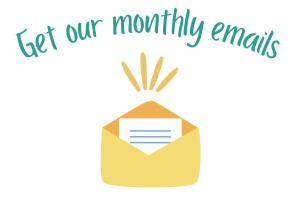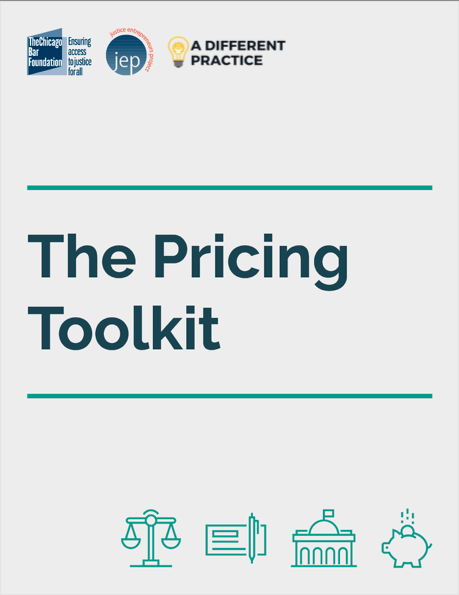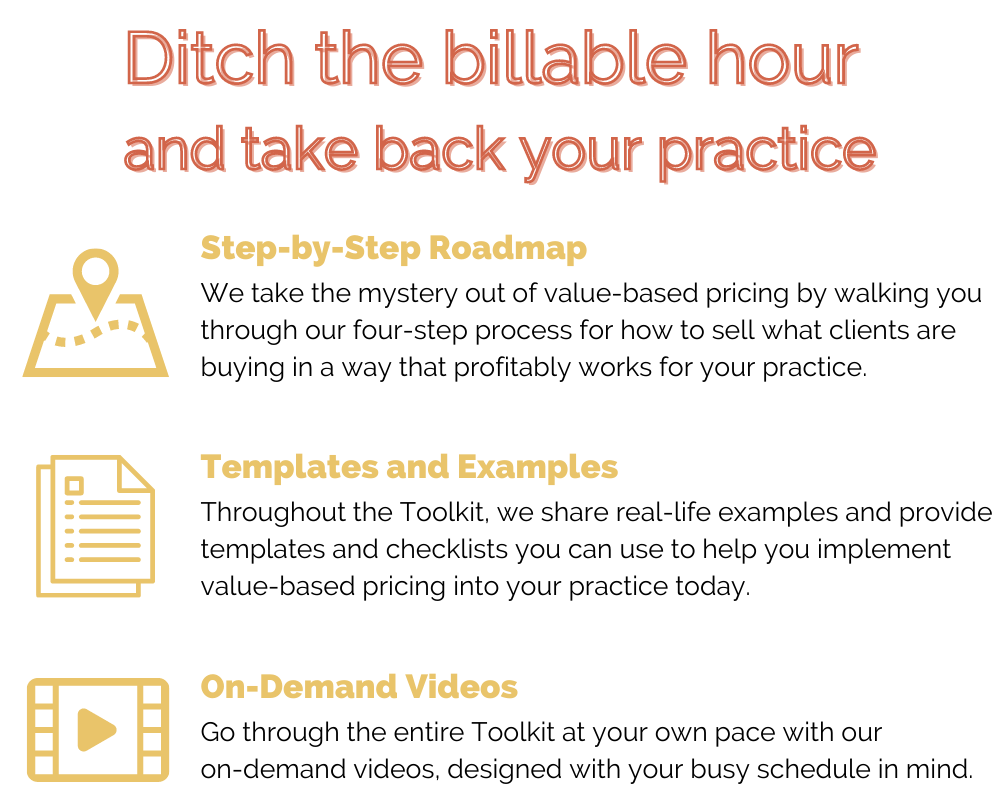
Ditching the Billable Hour Should Not Be a Mystery
Between time-tracking, collections, and burnout, lawyers want a more profitable and client-centric option to the billable hour. With The Pricing Toolkit, you’ll learn exactly how to price your services based on value instead of time so you can have a profitable and fulfilling practice.
The Pricing Toolkit is a collaboration between The Chicago Bar Foundation and A Different Practice. Helping lawyers price based on value instead of time is a core strategy for the CBF and ADP to increase access to justice and promote a healthier and more sustainable practice of law.
Download now to ditch the billable hour and change your practice forever!

Watch The Pricing Toolkit Videos
We’re so glad you’re here.
Welcome to The Pricing Toolkit! We are excited to have you here and help you envision a new way to practice law, one that is better for you and your clients. Let’s get started!
Key Takeaways
- Your practice is in your control.
- There’s a way to develop a profitable practice that supports well-being, but it requires a fundamental change to pricing.
Let’s dispel some common myths.
Before we dive into the benefits of value-based pricing, it’s important to first debunk five common myths associated with the billable hour and value-based pricing. In this video, we dispel the following misconceptions:
- The billable hour is the way it has always been done.
- Billing by the hour is the only way to be profitable.
- Using a fee arrangement that is not based on the billable hour is unethical.
- There are too many variables to offer a set fee.
- Set fees lead to a race to the bottom.
Key Takeaways
- Don’t let unsupported myths hold you back from value-based pricing!
In case you needed another reason to ditch the billable hour.
In addition to debunking the myths, we must also highlight more serious problems with the billable hour. In this video, we discuss how the billable hour lacks transparency and predictability, creates a conflict of interest, misaligns incentives, leaves no room for growth, and wreaks havoc on lawyer wellbeing.
Key Takeaways
- The billable hour lacks transparency and predictability, creates a conflict of interest, misaligns incentives, leaves no room for growth, and wreaks havoc on lawyer wellbeing.
- Value-based pricing is a win-win for the clients and lawyers.
Why it’s important to start every decision with the client.
Lawyers and legal companies say they want to be like Amazon and “start with the customer and work backward.” However, very few of them actually do so when it comes to pricing. In this video, we discuss how you can move from the traditional cost-based pricing approach to value-based pricing, which starts with the client.
Key Takeaways
- Value-based pricing starts with the client and assigns a price based on their value.
- The traditional approach of cost-based pricing starts with examining law firm costs and sets the price without consideration for the client.
- Value-based pricing is client-centric. Cost-based pricing is lawyer-centric.
Clients don’t buy time.
Legal consumers are not interested in buying your time. Instead, they only ever buy the value you provide in solving their legal problem. In this video, we discuss the concept of value and provide examples of how you can deliver it to your clients.
Be sure to check out the Elements of Value Fillable Pyramid.
Key Takeaways
- Clients do not buy your time. They only ever buy the value they receive.
- Value comes in many forms and should be considered expansively to include concepts specific to lawyering, like advocating, drafting, and negotiating, and concepts general to service industries, like providing options, predictable and transparent pricing, and good customer service.
Start with Value
The first step in the four-step framework is to determine the value. In this video, we discuss the five steps you need to take:
- Create your list of services.
- Identify the value you strive to provide for each of the services.
- Understand the variables and account for them.
- Determine the fee arrangements you will offer.
- Do some market research.
Check out the Creating a Pricing Menu Worksheets and Fee Matrix below under Templates & Additional Resources.
Key Takeaways
- A critical step in pricing services is to determine possible variables and account for them.
- There are three options to account for variables: limiting the scope of your representation to only the standard steps and exclude “known unknown” variables from the scope; spreading the cost of a variable event and the likelihood it will occur across all similar cases; and charging a flat fee for the first, small phase of a case so that you can dig in more and better identify the variables involved.
Sharpen your pencils – and erasers.
Once you have determined the value you will offer, it is time to assign an initial price. This video explains how to do this.
Check out the Creating a Pricing Menu Worksheets below under Additional Resources.
Key Takeaways
-
- The emphasis here is on the word initial! Don’t worry: before you put anything out into the world, we’ll help you confirm the price clients will pay covers your costs
Let’s crunch some numbers!
In this video, we help you calculate your monthly expenses, determine your desired monthly salary, determine your monthly profit percentage, and ultimately calculate your target monthly revenue.
Key Takeaways
- Target Monthly Revenue = Monthly Expenses + Gross Monthly Salary + Monthly Profit
Almost there!
The final step in our value-based pricing process is to assign the effort necessary to complete each service and adjust the initial pricing as needed. In this video, we discuss how to confirm the initial price you determined a potential client would pay for a particular service is a number that works for your business.
Check out the Creating a Pricing Menu Worksheets and Sample Process Maps under Additional Resources below.
Key Takeaways
- The importance of process mapping and understanding the amount of effort that goes into a case cannot be overstated. It’s a critical step to ensuring profitable pricing.
Wash, rinse, repeat.
Pricing your services will be an active, ongoing process for as long as you own your firm. In this video, we discuss how to effectively assess and adjust your pricing so that you can continue to provide the best client experience and grow your practice.
Key Takeaways
- While you may want to look at data on a case-by-case basis, remember, at the end of the day, you’re looking for an average.
- As you continue to review and tweak, you’ll get closer and closer to it.
Before you start…
You can have the best business model and pricing options in the world, but if you don’t properly set expectations, bring in compatible clients, and properly memorialize your agreements, your business model won’t bring in the revenue you want. In this video, we discuss how to set yourself up for success.
Key Takeaways
- Establishing client screening, setting expectations, and drafting comprehensive engagement agreements are critical to generating profit.
Find The Right Clients
The goal of the screening and intake process is to weed out clients who are not a good fit and to start providing value to the ones who are. In this video, we discuss how to identify both types of clients.
Key Takeaways
- Not every potential client is a good fit for your firm. Trust your gut!
- Refer those who are not a good fit to a firm that might be.
Set Expectations from the Jump
One of the best ways to get clients that align with your business model and pricing options is to set expectations before, during, and after the initial consultation. In this video, we discuss how to set expectations during each phase of the client journey.
Key Takeaways
- Setting expectations from the beginning and summarizing them in a comprehensive engagement agreement avoids unexpected and uncomfortable conversations when a case changes direction and the scope of the representation needs to be modified.
Get it in writing!
Now that you’ve done great work determining your pricing, it’s crucial to memorialize it properly in a comprehensive engagement agreement. This video discusses key provisions you’ll want to include in every engagement agreement.
Check out the Set Pricing Engagement Agreement Checklist and Sample Engagement Agreement Clauses below under “Additional Resources.”
Key Takeaways
- Setting expectations from the beginning and summarizing them in a comprehensive engagement agreement avoids unexpected and uncomfortable conversations when a case changes direction and the scope of the representation needs to be modified.
Money, money, money!
Providing value through set fees and making it easy for clients to pay you by using payment plans and offering electronic payment options leads to higher collection rates. In this video, we’ll share tips on collecting money and handling refunds.
Key Takeaways
- Value-based pricing can mean a 100% collection rate.
- Offering payment plans helps potential clients afford your services.
- Offering electronic payment options helps potential clients provide payment.
- If a client stops paying you, discuss it immediately and withdraw from the case if you cannot resolve it.
Congratulations!
Congratulations! You now have a law practice that maximizes value-based pricing.
You are on your way to having a successful and fulfilling practice that supports your well-being. That dream you had in the beginning is now becoming a reality. Welcome to the Happy and Successful Lawyers Club!
We look forward to continuing to serve as a resource and guide on your value-based pricing journey. Be sure to check out the templates and additional resources section. Please do not hesitate to reach out with questions. I’m here to help!
Additional Resources
The Pricing Toolkit
The Pricing Toolkit (printed format)
Templates
Elements of Value Fillable Pyramid
Fillable Pricing Menu Worksheet
Example Pricing Menu Worksheets
Engagement Agreement Checklist
Sample Engagement Agreement Clauses
Additional Resources
Implementing Value Pricing: A Radical Business Model for Professional Firms by Ronald J. Baker
Q. If I offer a fixed fee, will I be considered cheap?
A. You will only be viewed as cheap if you underprice your services. There is nothing inherently cheap about a fixed fee. Most legal consumers prefer a fixed fee because they value price certainly and the ability to determine if the solution you are offering fits within their budget. Our four-step framework in the Pricing Toolkit will help you align your pricing with your target market values and what the market will bear and ensure that your pricing covers your costs and works for your business.
Q. How do I know which fee arrangement is best for my business?
A. You’ll need to experiment! We recommend starting by reviewing the Fee Matrix in the Appendix of the Pricing Toolkit. It contains examples of fee arrangements that have worked for lawyers in various practice areas. Many lawyers will use more than one type of fee arrangement in their practice. It’s also okay to combine fee arrangements. For example, some lawyers will start a case by charging a fixed fee up to a particular milestone and then move to a monthly fixed fee arrangement. There is no one-size-fits-all answer here. The best approach is to consult the Fee Matrix and then pick a fee arrangement or two to start with, experiment, assess, and switch to a new fee arrangement if needed.
Q. My market research has not returned any helpful information. Now, what do I do?
A. First, pat yourself on the back for trying! Second, commit to be different and include pricing on your website. Then, keep on going! Continue working through the four-step pricing framework outlined in the Pricing Toolkit. Then, be sure to get feedback from clients. At the end of the matter, ask them how the price they paid compared with the value they received, and then, depending on their answer, make adjustments accordingly.
Q. My practice involves litigation and A LOT of variables. How do I offer value-based pricing?
A. We recognize that every case is different and that a wide range of variables could present themselves in a case at any given time. Here’s the good news: as long as you can list all of those potential variables, you can account for them in your pricing. Not sure if you have the experience to make this list? Pair up with a more experienced attorney who can prepare this list with you. Once you have the list, read the Pricing Toolkit and work through the four-step framework. As you’ll see, you have three accounting options for all the variables.
Q. How do I put a price on value?
A. We get this question a lot, so we dedicated an entire chapter of the Pricing Toolkit to this concept. Value comes in many forms and is ultimately determined by the client and what’s important to them. Check out the “Selling what Clients are Buying: A Deep Dive into Value” chapter of the Pricing Toolkit for more information.
Q. I’m afraid offering a set fee with a risk premium for a case with many variables will price people out of the market. What do you suggest?
A. Having price certainty and understanding whether legal solutions are budget-friendly is valuable to legal consumers, who are often willing to pay a little more to get it. We usually underestimate legal consumers and make assumptions about what they value most. What we’ve found is that if a legal consumer can understand the cost of the solution, they will find a way to come up with the money and pay your fee if they deem the solution valuable
Get Even More Free Resources
If the old antiquated approach to running a law firm isn’t working for you, sign up to receive exactly what to do so that you can work less and earn more.
Each month we send out curated resources that take the mystery out of building a profitable practice that supports your wellbeing.
We’re not trying to brag, but they’re pretty freaking great.
Sign up today!




